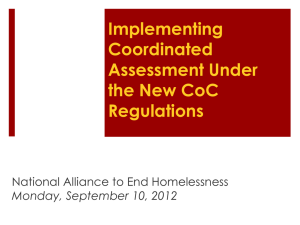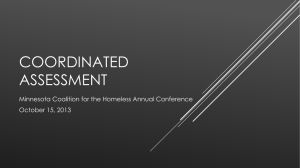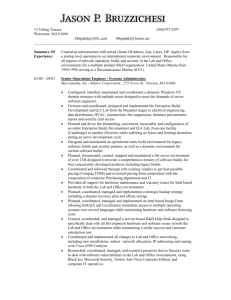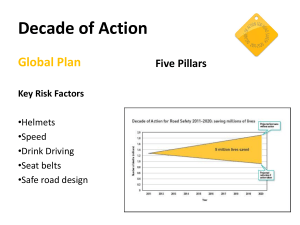Coordinated Assessment Checklist | DOC
advertisement
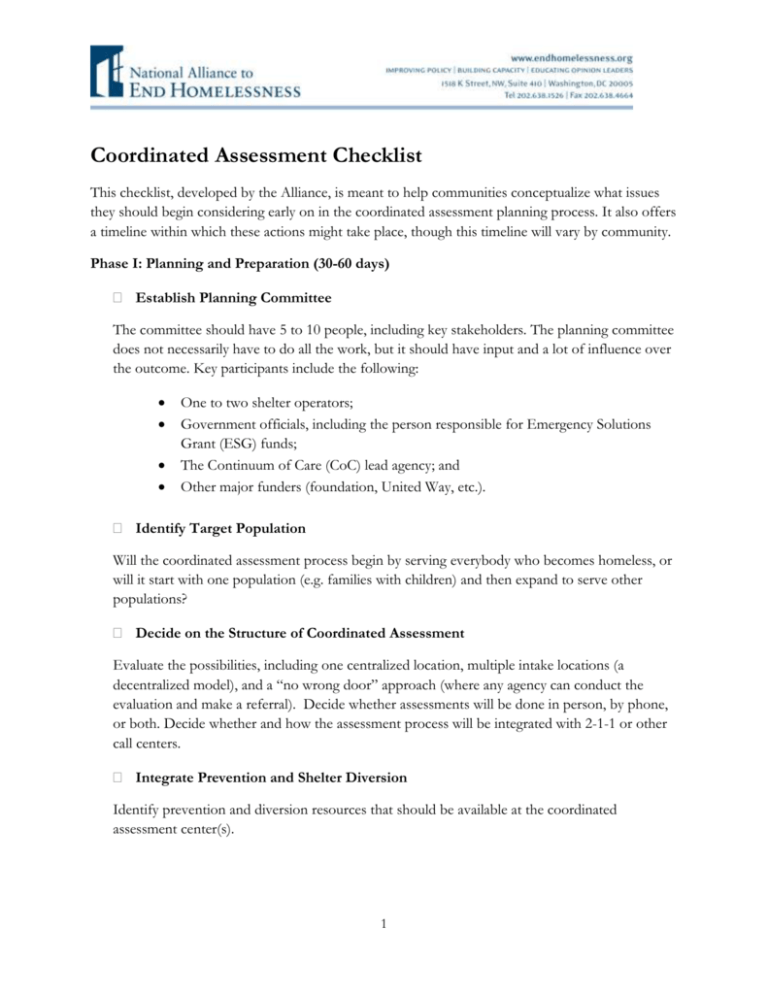
Coordinated Assessment Checklist This checklist, developed by the Alliance, is meant to help communities conceptualize what issues they should begin considering early on in the coordinated assessment planning process. It also offers a timeline within which these actions might take place, though this timeline will vary by community. Phase I: Planning and Preparation (30-60 days) Establish Planning Committee The committee should have 5 to 10 people, including key stakeholders. The planning committee does not necessarily have to do all the work, but it should have input and a lot of influence over the outcome. Key participants include the following: One to two shelter operators; Government officials, including the person responsible for Emergency Solutions Grant (ESG) funds; The Continuum of Care (CoC) lead agency; and Other major funders (foundation, United Way, etc.). Identify Target Population Will the coordinated assessment process begin by serving everybody who becomes homeless, or will it start with one population (e.g. families with children) and then expand to serve other populations? Decide on the Structure of Coordinated Assessment Evaluate the possibilities, including one centralized location, multiple intake locations (a decentralized model), and a “no wrong door” approach (where any agency can conduct the evaluation and make a referral). Decide whether assessments will be done in person, by phone, or both. Decide whether and how the assessment process will be integrated with 2-1-1 or other call centers. Integrate Prevention and Shelter Diversion Identify prevention and diversion resources that should be available at the coordinated assessment center(s). 1 Map out the Existing Assessment and Intake Process Create a map of the existing assessment, intake, and referral process and how people move through the system within it. What are the flaws with this process and how can they be addressed with a more coordinated approach? What are the good aspects that should be included in the new model? Sketch out a Preliminary Needs Assessment/Screening Tool Identify questions to be asked and begin mapping how referrals will work. This should be very basic and will be modified as the process moves forward. Phase II: Implementation (4-6 months) Identify the Organization(s) That Will Host Coordinated Assessment Which organizations have the space, staff capacity, and availability to host the intake, if any? Will there need to be multiple organizations or just one? What changes need to be made to enable the organization to take on multiple responsibilities? Communities may have different organizations for each different subpopulation (families, unaccompanied youth, etc.). Identify Additional Staffing and Resource Needs Think about what staff you will use at the coordinated assessment points and how many you will need based on anticipated intake volume. Trained case managers will be crucial to the success of the assessment process. Technological needs, including computers and the necessary data management programs, access to information on community resources, etc. will all be necessary. Obtain Resources Obtain the resources needed by either pulling them from elsewhere in the community (e.g., having providers agree to “share” case management staff with the coordinated entry points) or hiring new staff. Identify Data and HMIS Needs Make sure the current HMIS system can collect and report out on the outcomes relevant to coordinated assessment. Create capacity to identify bed availability in real time. 2 Train People on the Data and HMIS Procedures Involved in Coordinated Assessment Process Staff should be trained on when to start entering data, what data must be entered, and how to share data with referral organizations. Begin Changing Contract Language to Ensure That as Many Partners as Possible Are Participating in the Coordinated Assessment Process The community should offer strong incentives to providers to participate in coordinated assessment, including tying receipt of funds to participation. This could be accomplished through the advent of a performance-based contracting process. Create a Plan for How the Coordinated Assessment Will Be “Switched On” A firm plan should be established that includes dates, times, and contingency plans in case anything should go wrong. Finalize the Version of the Screening/Assessment Tool That Will Be Used When the Coordinated Intake Goes Into Effect Make sure that intake staff is familiar with the assessment tool and how to make referrals based on the information within it before the new coordinated assessment process goes into effect. Create a Specific Referral Process What constitutes a referral? How does the referral get made? When must an organization accept a referral? When can it be denied, and what happens when referrals are denied? Identify a Process for Evaluating and Making Adjustments to the Coordinated Assessment Process This may involve having a version of the planning committee that continues to oversee the coordinated assessment process. How often will evaluation meetings occur? How will changes to the intake process be decided upon? What are the key outcome measures? Create a Communications Plan Key partners in the community, including mainstream service partners, government officials, consumers, and the general public will need to be notified about how the new coordinated 3 assessment works. Social media, brochures, and informational meetings are just some of the avenues communities could use to make this happen. Phase 3: Flip the Switch: Begin Utilizing the Coordinated Assessment System (ongoing) Evaluate Coordinated Assessment Evaluate the new process on the following metrics: o Are there long waiting lists, if so what adjustments need to be made in the referral process? o Is the evaluation tool working? Are there questions that should be eliminated or different questions that should be asked? The community should also use the tools in this toolkit when evaluating their success: Coordinated Assessment Questionnaire Coordinated Assessment Evaluation Tool 4
